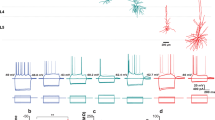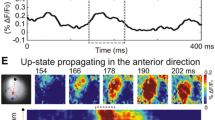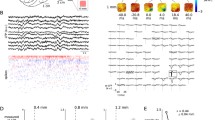Abstract
Stellate cells (SCs) of the entorhinal cortex generate prominent subthreshold oscillations that are believed to be important contributors to the hippocampal theta rhythm. The slow inward rectifier I h is expressed prominently in SCs and has been suggested to be a dominant factor in their integrative properties. We studied the input-output relationships in stellate cells (SCs) of the entorhinal cortex, both in control conditions and in the presence of the I h antagonist ZD7288. Our results show that I h is responsible for SCs’ subthreshold resonance, and contributes to enhanced spiking reliability to theta-rich stimuli. However, SCs still exhibit other traits of rhythmicity, such as subthreshold oscillations, under I h blockade. To clarify the effects of I h on SC spiking, we used a generalized form of principal component analysis to show that SCs select particular features with relevant temporal signatures from stimuli. The spike-selected mix of those features varies with the frequency content of the stimulus, emphasizing the inherent nonlinearity of SC responses. A number of controls confirmed that this selectivity represents a stimulus-induced change in the cellular input-output relationship rather than an artifact of the analysis technique. Sensitivity to slow features remained statistically significant in ZD7288. However, with I h blocked, slow stimulus features were less predictive of spikes and spikes conveyed less information about the stimulus over long time scales. Together, these results suggest that I h is an important contributor to the input-output relationships expressed by SCs, but that other factors in SCs also contribute to subthreshold oscillations and nonlinear selectivity to slow features.






Similar content being viewed by others
References
Acker CD, Kopell N, White JA (2003) Synchronization of strongly coupled excitatory neurons: Relating network behavior to biophysics. J. Comput. Neurosci. 15: 71–90.
Adachi T, Robinson DM, Miles GB, Funk GD (2005) Noradrenergic modulation of xii motoneuron inspiratory activity does not involve alpha2-receptor inhibition of the ih current or presynaptic glutamate release. J. Appl. Physiol. 98: 1297–1308.
Adelman TL, Bialek W, Olberg RM (2003) The information content of receptive fields. Neuron 40: 823–833.
Aguera Y Arcas B, Fairhall AL (2003) What causes a neuron to spike? Neural. Comput. 15: 1789–1807.
Alonso A, Llinás RR (1989) Subthreshold na+-dependent theta-like rhythmicity in stellate cells of entorhinal cortex layer ii. Nature 342: 175–177.
Alonso A, Klink R (1993) Differential electroresponsiveness of stellate and pyramidal-like cells of medial entorhinal cortex layer ii. J. Neurophysiol. 70: 128–143.
Brenner N, Strong SP, Koberle R, Bialek W, de Ruyter van Steveninck RR (2000) Synergy in a neural code. Neural. Comput. 12: 1531–1552.
Buzsáki G (2002) Theta oscillations in the hippocampus. Neuron 33: 325–340.
Caplan JB, Madsen JR, Schulze-Bonhage A, Aschenbrenner-Scheibe R, Newman EL, Kahana MJ (2003) Human {theta} oscillations related to sensorimotor integration and spatial learning. J. Neurosci. 23: 4726–4736.
Chevaleyre V, Castillo PE (2002) Assessing the role of ih channels in synaptic transmission and mossy fiber ltp. Proc. Natl. Acad. Sci. USA 99: 9538–9543.
Clague H, Theunissen F, Miller JP (1997) Effects of adaptation on neural coding by primary sensory interneurons in the cricket cercal system. J. Neurophysiol. 77: 207–220.
Dayan P, Abbott LF (2001) Theoretical Neuroscience: Computational and Mathematical Modeling of Neural Systems, Edition. Massachusetts Institute of Technology Press, Cambridge, Mass.
Dickson CT, Magistretti J, Shalinsky MH, Fransen E, Hasselmo ME, Alonso A (2000) Properties and role of i(h) in the pacing of subthreshold oscillations in entorhinal cortex layer ii neurons. J. Neurophysiol. 83: 2562–2579.
Fairhall AL, Lewen GD, Bialek W, de Ruyter Van Steveninck RR (2001) Efficiency and ambiguity in an adaptive neural code. Nature 412: 787–792.
Fellous JM, Houweling AR, Modi RH, Rao RP, Tiesinga PH, Sejnowski TJ (2001) Frequency dependence of spike timing reliability in cortical pyramidal cells and interneurons. J. Neurophysiol. 85: 1782–1787.
Fries P, Roelfsema PR, Engel AK, Konig P, Singer W (1997) Synchronization of oscillatory responses in visual cortex correlates with perception in interocular rivalry. Proc. Natl. Acad. Sci. USA 94: 12699–12704.
Gray CM, Konig P, Engel AK, Singer W (1989) Oscillatory responses in cat visual cortex exhibit inter-columnar synchronization which reflects global stimulus properties. Nature 338: 334–337.
Haas JS, White JA (2002) Frequency selectivity of layer ii stellate cells in the medial entorhinal cortex. J. Neurophysiol. 88: 2422–2429.
Hasselmo ME, Bodelon C, Wyble BP (2002) A proposed function for hippocampal theta rhythm: Separate phases of encoding and retrieval enhance reversal of prior learning. Neural. Comput. 14: 793–817.
Hu H, Vervaeke K, Storm JF (2002) Two forms of electrical resonance at theta frequencies, generated by m-current, h-current and persistent na+ current in rat hippocampal pyramidal cells. J. Physiol. 545: 783–805.
Hunter JD, Milton JG (2003) Amplitude and frequency dependence of spike timing: Implications for dynamic regulation. J. Neurophysiol. 90: 387–394.
Hunter JD, Milton JG, Thomas PJ, Cowan JD (1998) Resonance effect for neural spike time reliability. J. Neurophysiol. 80: 1427–1438.
Hutcheon B, Yarom Y (2000) Resonance, oscillation and the intrinsic frequency preferences of neurons. Trends Neurosci 23:216–222.
Jensen RV (1998) Synchronization of randomly driven nonlinear oscillators. Physiol. Rev. E 58: 6907–6910.
Klink R, Alonso A (1993) Ionic mechanisms for the subthreshold oscillations and differential electroresponsiveness of medial entorhinal cortex layer ii neurons. J. Neurophysiol. 70: 144–157.
Mainen ZF, Sejnowski TJ (1995) Reliability of spike timing in neocortical neurons. Science 268: 1503–1506.
Niebur E, Hsiao SS, Johnson KO (2002) Synchrony: A neuronal mechanism for attentional selection? Curr. Opin. Neurobiol. 12: 190–194.
O’Keefe J, Recce ML (1993) Phase relationship between hippocampal place units and the eeg theta rhythm. Hippocampus 3: 317–330.
Raghavachari S, Kahana MJ, Rizzuto DS, Caplan JB, Kirschen MP, Bourgeois B, Madsen JR, Lisman JE (2001) Gating of human theta oscillations by a working memory task. J. Neurosci. 21: 3175–3183.
Richardson MJ, Brunel N, Hakim V (2003) From subthreshold to firing-rate resonance. J. Neurophysiol. 89: 2538–2554.
Roelfsema PR, Engel AK, Konig P, Singer W (1997) Visuomotor integration is associated with zero time-lag synchronization among cortical areas. Nature 385: 157–161.
Schreiber S, Erchova I, Heinemann U, Herz AV (2004) Subthreshold resonance explains the frequency-dependent integration of periodic as well as random stimuli in the entorhinal cortex. J. Neurophysiol. 92: 408–415.
Schreiber S, Fellous J-M, Tiesinga P, Sejnowski TJ (2004) Influence of ionic conductances on spike timing reliability of cortical neurons for suprathreshold rhythmic inputs. J. Neurophysiol. 91: 194–205.
Shannon CE (1948) A mathematical theory of communication. Bell Syst. Tech. J. 27: 379–423; 623–656.
Singer W (1999) Neurobiology. Striving for coherence [news; comment]. Nature 397: 391–393.
Winson J (1978) Loss of hippocampal theta rhythm results in spatial memory deficit in the rat. Science 201: 160–163.
Acknowledgments
We owe thanks to the faculty and organizers of the Methods in Computational Neuroscience course at the Marine Biological Lab (Woods Hole, MA, USA), where this project was started. We are particularly grateful to William Bialek, former co-Director of MCN, who provided substantial guidance in use of GPCA and information theoretic methods. We thank Kamal Sen and Jon Shlens for helpful discussions, and Kyle Lillis for reading a preliminary version of the manuscript. This work was supported by grants from the National Institutes of Health (R01 MH61604, R01 NS34425) to J.A. White.
Author information
Authors and Affiliations
Corresponding author
Additional information
Action Editor: Xiao-Jing Wang
Rights and permissions
About this article
Cite this article
Haas, J.S., Dorval II, A.D. & White, J.A. Contributions of I h to feature selectivity in layer II stellate cells of the entorhinal cortex. J Comput Neurosci 22, 161–171 (2007). https://doi.org/10.1007/s10827-006-0005-7
Received:
Revised:
Accepted:
Published:
Issue Date:
DOI: https://doi.org/10.1007/s10827-006-0005-7




